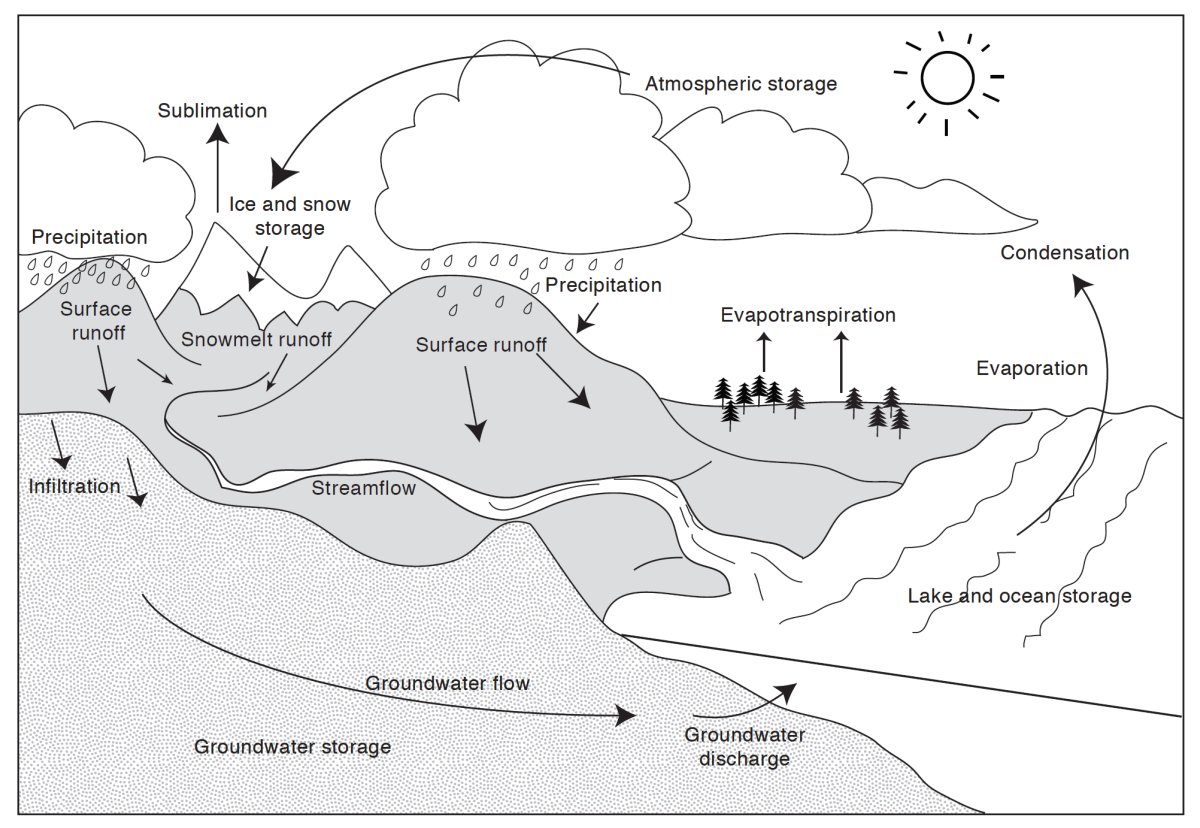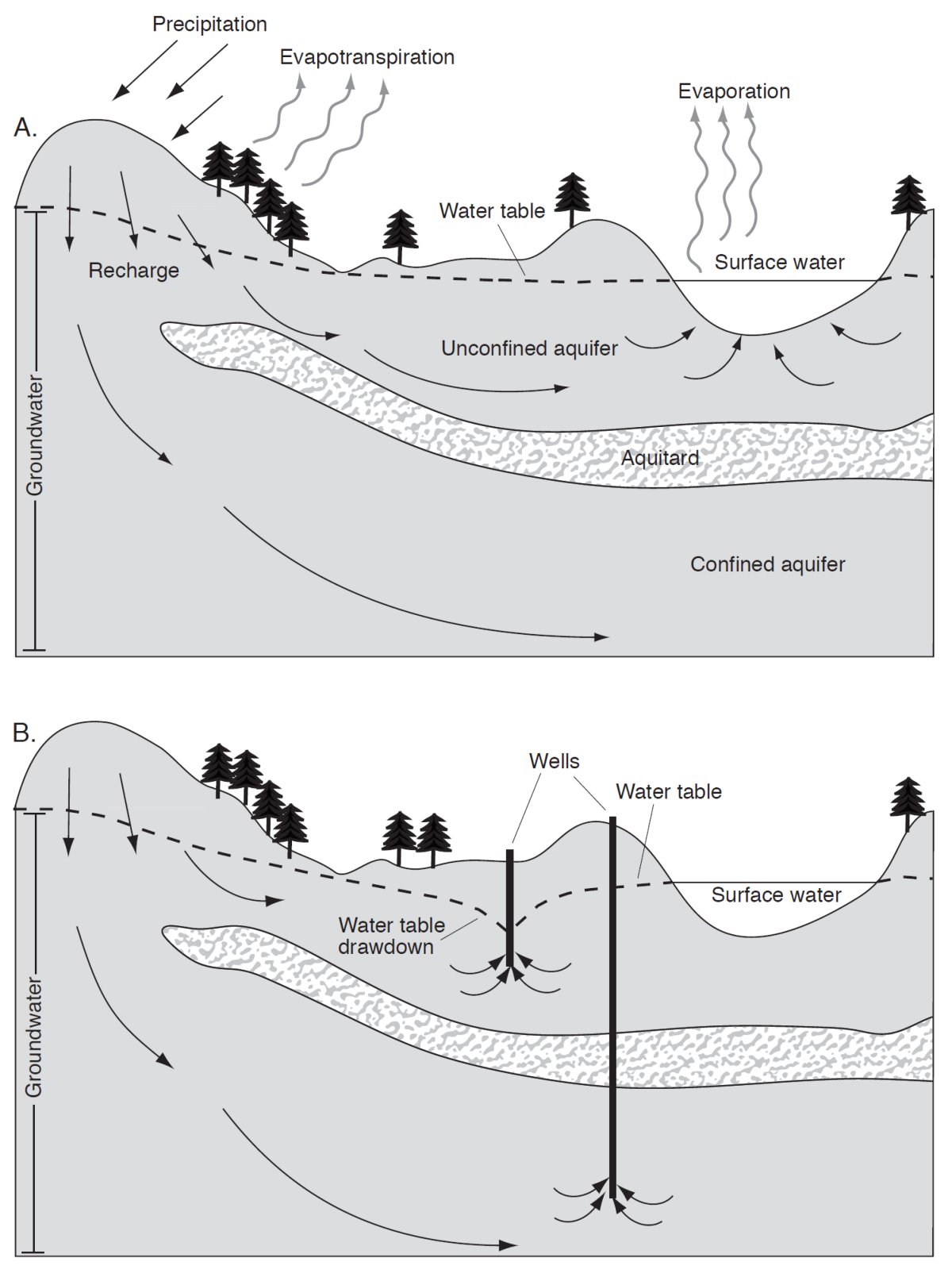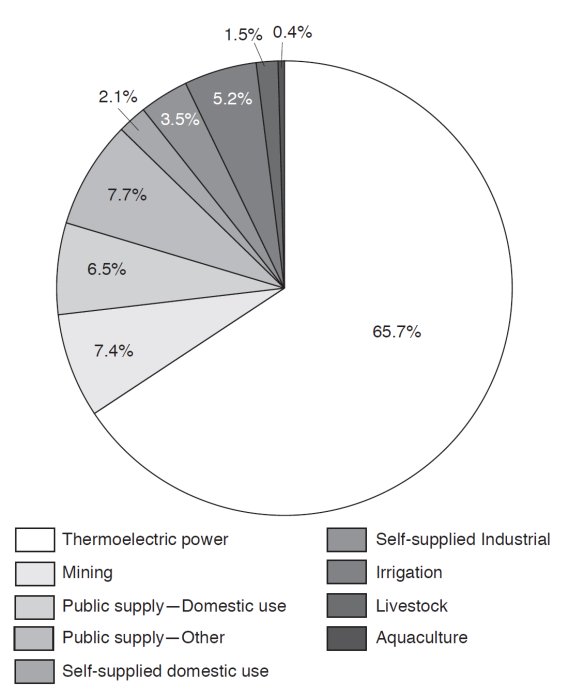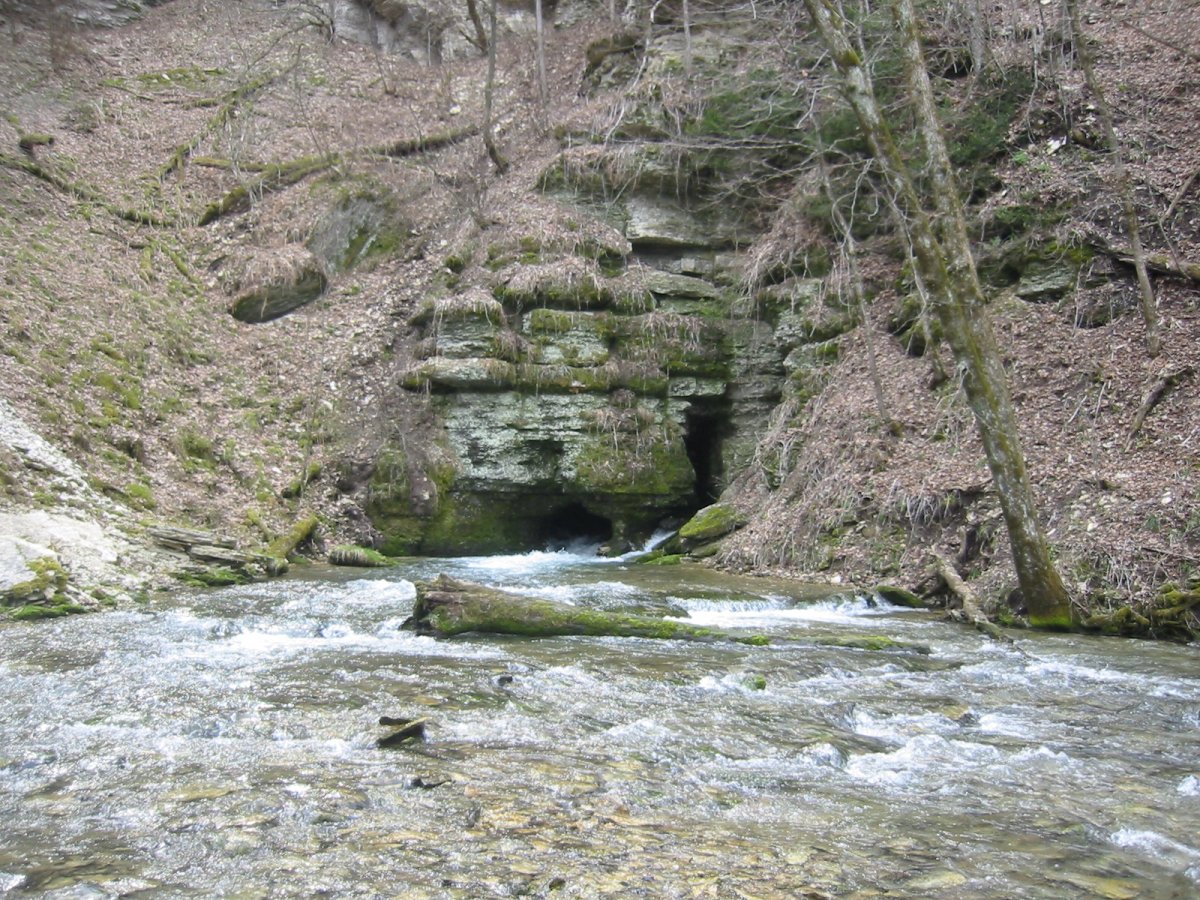Water
Water is arguably the most important resource on our planet. All life depends on it for survival. Approximately 71% of the surface of the Earth is water and of this, about 97% is saltwater. Where fresh water is present largely depends on geology, geographic location, global weather processes, and topographic variability.
Water cycle
The Water Cycle - This video uses animation, graphics, and video clips to illustrate and explain each of the "flow" and "storage" processes in the Hydrologic Cycle, more commonly known as the Water Cycle: precipitation, interception, runoff, infiltration, percolation, groundwater discharge, evaporation, transpiration, evapotranspiration, and condensation.
Video courtesy of NBC Learn & National Science Foundation
Water moves through the environment fairly predictably in a progression known as the water cycle (Fig. 1). It "starts" when surface water (such as rivers, lakes, or oceans) becomes a gas and enters the atmosphere through evaporation, evapotranspiration (the conversion of water from liquid to gas via transpiration of plants and evaporation from soil), or sublimation (the process by which solid water changes directly to gas); the gaseous water condenses in the air and forms clouds. As the clouds build and the amount of water increases, it precipitates out of the atmosphere (commonly as rain or snow), landing on the ground or in water. Frozen water can be stored as ice and snow for a significant period of time, but like rain, when it melts, it either infiltrates into the ground (becoming groundwater), or runs off the land surface into streams or lakes. Both streams and groundwater eventually recharge larger water bodies such as rivers, lakes, and oceans. Once at the surface, water "restarts" the cycle as it evaporates back into the atmosphere.

Reservoirs and residence time
As mentioned above, there are numerous places, or reservoirs, where water is stored for varying lengths of time. The largest reservoirs are the oceans, which contain about 97% of the total water on the planet and are entirely saltwater. Fresh water comprises about 3% of total water, with the majority (69%) of that being stored as ice or snow (90% of which is in Antarctica). The next largest reservoir of fresh water, at 30%, is groundwater. Surface-water reservoirs, such as lakes and streams, make up 1% of fresh water, and the atmosphere stores only a tiny fraction.
How long water stays in each of these reservoirs (residence time) varies from days (the atmosphere) to thousands of years (oceans and some groundwater). Table 1 shows the average residence times for each reservoir. It is important to keep in mind that these are only averages and the actual range could be quite broad. For instance, though seasonal snow might last several months, depending on the location and conditions, some may sublimate within hours or days.
| Reservoir | Residence time (average) |
|---|---|
| Oceans | 3,000 to 3,230 years |
| Glaciers | 20 to 100 years |
| Seasonal snow cover | 2 to 6 months |
| Soil moisture | 1 to 2 months |
| Groundwater—shallow | 0 to 200 years |
| Groundwater—deep | 10,000 years |
| Lakes | 50 to 100 years |
| Rivers | 2 to 6 months |
| Atmosphere | 9 days |
Groundwater
Groundwater is an extremely important resource because we rely on it for much or most of our consumable water. It is the second largest reservoir of fresh water on Earth (30%). Groundwater sources that yield a significant amount of water are called aquifers (Fig. 2A). Aquifers are permeable bedrock (typically sandstone, carbonate, or fractured rock) or subsurface sediments (sand and gravel); the more primary pore space (empty space between individual gains) and secondary pore space (empty space in rocks due to cracks and fractures) there is in these geologic units, the more water can be stored in them. Although the amount of pore space plays an important role in the amount of groundwater, subsurface water volume also varies depending on geographic location, precipitation amounts, season, or even human consumption; the water table (the upper surface of saturation) will rise and fall depending on these factors. Aquifers are recharged when precipitation or surface water infiltrates into the ground. There can be multiple aquifers that overlie each other in the subsurface that are separated by confining layers called aquitards; these are layers of clay-rich sediments or non-porous rock that restrict the vertical flow of groundwater. An aquifer in which water can seep directly into it from the ground surface is known as an unconfined aquifer; these are typically recharged by precipitation or stream and lake water infiltration. A confined aquifer is one that lies under an aquitard and cannot receive recharge directly from the surface; instead, confined aquifers are recharged by water that infiltrates into the ground many miles away and flows into it (Fig. 2).

Groundwater is extracted from the subsurface by pumping from wells (Fig. 2B). These wells are constructed using large drills mounted on trucks. Depending on the type of material being drilled, reaching a productive aquifer can take a few hours to a few days. A pump is placed deep in the hole to force water up to the surface. When a significant amount of pumping occurs in one location and is drawing from a single aquifer, it can cause the water level surrounding the well(s) to lower, an effect called drawdown (Fig. 2B), which can affect the water level in nearby wells, ponds, or lakes. If high pumping rates continue, the water level in the well can drop below the level of the pump, and even nearby lakes and ponds can dry up. Once pumping ceases, the aquifer may recover through recharge.
Water in Minnesota
The location and climate of Minnesota drive the distribution of water throughout the state. Minnesota sits at a drainage divide for three continental-scale watersheds, meaning that almost all water in Minnesota flows out of the state; therefore, Minnesota derives all of its water from precipitation. Most moisture falls in the state during the spring and summer months when warm, humid air masses from the Gulf of Mexico can penetrate farther north. However, a large amount of groundwater recharge occurs in the spring and autumn when there is less water loss from evapotranspiration. For this same reason, snowmelt in the spring contributes to a significant amount of groundwater recharge. Located in the central United States, Minnesota sits between the semi-humid and semi-arid climates of the east and west. This means that there is a large gradient of water availability from west to east across the state. The western edge of the state experiences more evapotranspiration than is replenished by precipitation, leading to drier environments. The eastern half of the state is the opposite, with greater annual precipitation amounts relative to the amount of evapotranspiration; this creates an environment with large forests and extensive wetlands.
Water use in Minnesota
Here in Minnesota, we have an abundance of water; with our "10,000 lakes" we are no strangers to this important resource. But why is this so important? How do we use the water available to our community, and how much does everyone actually use? Figure 3 shows the primary water uses in the state, as well as the percentage of water consumed by each group.

Domestic (personal) use may seem like the most obvious way we consume water, because we use it every day; however, it only makes up 8.1% of the total water usage in Minnesota. Of the total amount of water used domestically, about 70% is from groundwater and the remaining 30% is from surface water (the Twin Cities are the primary consumers of this surface water). While some domestic water use is self-supplied to consumers via private wells, the majority of the population, about 79%, relies on the public water supply for their everyday needs such as drinking, cleaning, bathing, and cooking. Watering yards and washing cars also account for a portion of this consumption. The average Minnesotan uses about 63 gallons of water per day; that's about the amount needed to fill a standard bathtub! An average family of four uses about 252 gallons of water every day. This may not seem like a lot, but when you consider how many people live in the state (about 5.5 million), it really adds up; that's 5.5 million full bathtubs, or over 345 million gallons of water used every day, just by people living their normal lives! Other uses of public-supplied water in Minnesota make up about 6.5% of total consumption, and include services such as public pools, parks, firefighting, wastewater treatment, municipal buildings, and some industrial use. About 3.5% of total water consumption is self-supplied by industries for uses including washing, processing, dilutions, cooling, and sanitation.
By far the largest consumer of water (65.7% of total water use) in Minnesota is thermoelectric power. Almost 100% of the water is from surficial sources and is used exclusively for cooling systems. About 62% of this is used for once-through cooling, is not consumed by the plant, and is returned directly to the withdrawal source; the remaining 38% is used in recirculation cooling systems, meaning it is recycled by the plant until it eventually evaporates and is returned to the environment as steam. In this way, though thermoelectric power uses the highest percentage of water, it does not actually consume the whole amount.
Mining practices use 7.4% of the total water Minnesota. Historically, mining has played a large role in the economic and cultural growth of the region. Today, large mines produce taconite and other materials that are sold and shipped across the globe, making the industry an important contributor to the Minnesota economy. Water is used for the extraction of ore through practices such as quarrying, milling, water injection, and dampening roads for dust control.
Irrigation accounts for 5.2% of the total water consumption in the form of sprinkler and surface irrigation, and about 87% of withdrawals for irrigation are from groundwater reservoirs. If there is a large amount of pumping on a single aquifer, then there could be a problematic water-level decline (Fig. 2B). The primary use of this resource is agriculture; however, golf courses and parks are also included in this category. Commonly, water used for irrigation is mixed with fertilizers, manure, and pesticides that are intended to nourish and protect crops or grasses. Any water (including these additives) that is not consumed by the plants either runs off into nearby streams or ponds, or re-enters the groundwater reservoir. This contaminated water is often high in nitrate, which if consumed by humans can lead to health problems, especially in infants and pregnant women. In areas with potentially high nitrate concentrations, the Minnesota Department of Health enforces federal regulations on preventing and treating nitrate contamination in drinking water (the Safe Drinking Water Act), and public water systems are routinely monitored and treated for contamination. Nitrate does occur naturally in small amounts when microorganisms in the soil break down organic matter; however, in these concentrations it is not considered harmful.
Livestock and aquaculture (raising organisms for food, conservation, or sport) account for 1.9% of total water consumption in Minnesota. The water is used for habitat, watering, sanitation, and cooling facilities.
Humans are not the only organisms that require water. Minnesota has numerous ecosystems that rely on the abundance of water present in the environment. The numerous lakes, lush forests, peat bogs, and aquatic habitats all require groundwater and surface water resources to maintain good health.
Lastly, though it can't be quantified, water is used for recreation. Minnesota is known for its "10,000 lakes," rivers, the Boundary Waters Canoe Area Wilderness, boating, and fishing. Outdoor recreation is very popular among Minnesotans, and our water resources are a large part of that. Not only are these activities important to residents of Minnesota, but they also attract tourists from other states. According to the U.S. Department of Agriculture, the Boundary Waters Canoe Area Wilderness alone attracted 146,177 total visitors in 2015; and in 2016 there were 1.6 million licensed anglers in Minnesota! Those who enjoy these types of activities know the value of Minnesota water resources and recognize the importance of protecting their quality and integrity.
